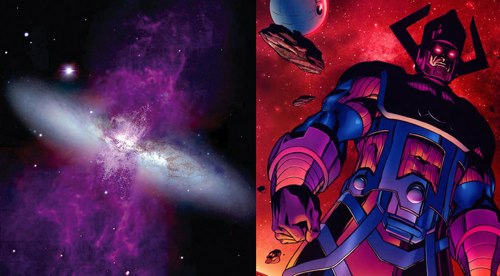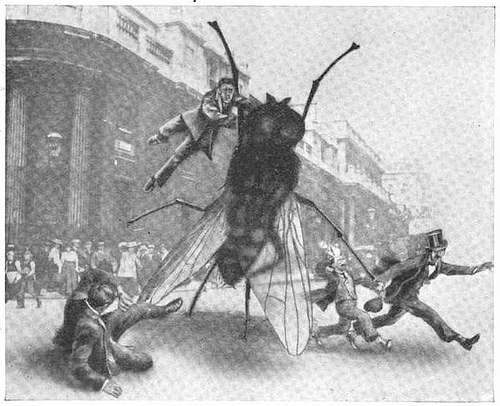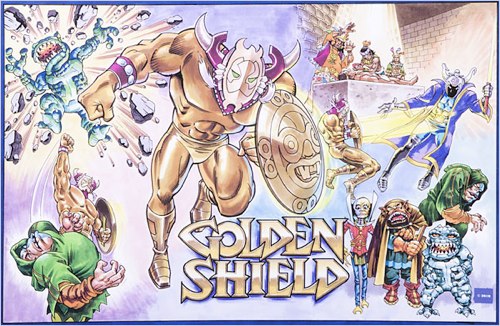Posted by Justin on April 17th, 2010
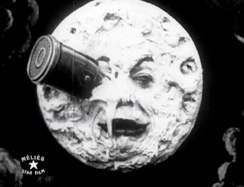
Hey space fans, don’t be blue that Mean Ol’ Obama said we aren’t sending men to the moon anytime soon. Because once we get there… our pad is going to be totally sick thanks to a new 3-D printing technology that could turn boring lunar dust and moon rocks into a bomb ass base of operations.
Future astronauts might end up living in a moon base created largely from lunar dust and regolith, if a giant 3-D printing device can work on the lunar surface.
The print-on-demand technology, known as D-Shape, could save on launch and transportation costs for manned missions to the moon. But the concept must first prove itself in exploratory tests funded by the European Space Agency (ESA)
“We will make very basic printing trials in a vacuum environment to verify if this is possible,” said Enrico Dini, chairman of Monolite UK Ltd and creator of D-Shape.
Dini’s D-Shape has created full-size sandstone buildings on Earth by using a 3-D printing process similar to how inkjet printers work. It adds a special inorganic binder to sand so that it can build a structure from the bottom up, one layer at a time.
Totally sweet.
[Yahoo!]
Posted in Space | |
Comments (1)
Posted by Justin on April 16th, 2010
No one expects to Sget their camera stolen by an octopus. Which makes it the perfect crime…
[Stuff.co.nz via Pharyngula]
Posted in Animal Attack | |
Comments Off on New Zealand Cameraman Gets Mugged By Octopus
Posted by Justin on April 16th, 2010
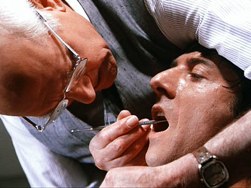
Ever pointed out which tooth is killing you to the dentist, only for the smug dong to give you a wide-eyed glance, then shoot a bemused look at the hygienist, then give you a patronizing “suuuuuuuure it’s the back right molar” whilst stifling a giggle?
Well as it turns out, our brains have a really hard time pin-pointing if tooth pain comes from the bottom or the top. Jerk.
The results, which will be published in the journal Pain, help explain why patients are notoriously bad at pinpointing a toothache.
For the most part, humans are exquisitely tuned to pain. The brain can immediately distinguish between a splinter in the index finger and a paper cut on the thumb, even though the digits are next-door neighbors. But in the mouth this can be more difficult, depending where and how intense the ache is.
“We don’t know much about tooth pain,” comments dentist and neuroscientist Alexandre DaSilva of the University of Michigan in Ann Arbor, who was not part of the new research. The new study is one of the first to address the puzzle of toothache localization, he says.
Also, dentists are the The Back Up Plan of doctors.
[Science News]
Posted in Pain | |
Comments Off on Your Brain Can’t Tell Up From Down Inside Your Mouth
Posted by Justin on April 16th, 2010
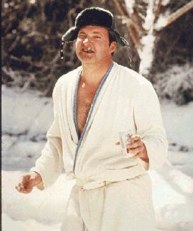
From Stone Pages.com.
Researchers from the Max Planck Institute for Evolutionary Anthropology in Leipzig recently announced that analysis of DNA from a tiny fragment of bone from the Denisova Cave in the Siberian Altai Mountains indicates that it may belong to a hitherto unknown hominid type.
John Krause and colleagues managed to isolate a complete sequence of mitochondrial DNA from a fragment of finger bone found by Russian researchers in 2008 that weighed only 30mg. This was compared with 54 sequences from modern humans, an early human sequence from Kotenski, Russia, six from Neanderthals, and one each from a chimpanzee and a bonobo. While Neanderthal mitochondrial DNA sequences have on average 202 differences from modern human sequences, the Denisova sequence has almost twice that number.
The director of the Institute’s genetics department, Svante Pääbo said “The results practically blew me away when I heard.” The researchers suggest the Denisova hominid shared a common ancestor with both Neanderthals and anatomically modern humans, and may have lived alongside them as recently as 30,000 to 48,000 years ago. In turn, this completely new mitochondrial DNA sequence might imply a fourth wave of hominin migration out of Africa.
You might remember a similar point being raised by Andrew (with a far darker ending) on the most recent Weird Things podcast.
[Stone Pages]
Posted in Paleo Pals | |
Comments Off on Family Gets More Crowded, Evidence Of New Human Relative Found
Posted by Justin on April 16th, 2010
Panicked cheeseheads across the Quad Cities area of Wisconsin reported seeing a massive fireball light up the night sky on Wednesday. But, was the brilliant streaking light, thought to be caused by a meteor shower, just a repeat of another similar phenomenon that some believe left far greater devastation nearly a century and a half ago?
In short, could a fireball like this be what ignited the Great Chicago Fire?
In 2004 engineer and physicist Robert M. Wood posited exactly that, citing other fires that began at the same time the Chi Town conflagration began in… guess where… the farming towns of Wisconsin!
All of this has happened before and it will happen again. Except now we have modern fire brigades and flame extinguishing foam.
[CNN]
Posted in Meteor | |
Comments Off on Was The Wisconsin Fireball The Same Kind That Started The Chicago Fire?
Posted by Justin on April 15th, 2010
Who needs The Watcher? According to radio astronomers at the University of Manchester, a “baffling new object” in a nearby galaxy is unlike anything they’ve seen before.
But those who know better sure recognize that color scheme, that stature…
The object appeared very suddenly last May at radio wavelengths and has persisted ever since, showing no signs of going away. It was originally thought to be a young supernova, as M82 is a known star nursery. But most of M82’s stars die quickly in massive stellar explosions — a new supernova generally occurs once every two or three decades — at which point their radio wavelengths begin a slow decay. The mystery object has shown no such signs of dimming.
I for one welcome our new world eating overlord.
[PopSci]
Posted in Astronomy, Galactus | |
Comments (2)
Posted by Justin on April 15th, 2010
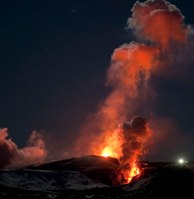
From CNN:
European countries shut their airspace one after the other Thursday as a cloud of volcanic ash wafted over from Iceland and posed a danger to flights.
Airspace over the United Kingdom was due to be closed for six hours from midday but air authorities later extended the closure until at least 7 a.m. BST (2 a.m. EDT) Friday…
In all, around 3,000 flights across Europe were expected to be affected by the closures, according to Eurocontrol, the intergovernmental body that manages European air travel.
Many airports were already shut and flights were grounded across the United Kingdom on Thursday because of the ash, which came after an eruption under an Icelandic glacier early Wednesday, airport authorities said.
The ash cloud came from an eruption of a volcano beneath Iceland’s Eyjafjallajokull glacier early Wednesday.
…just as you were getting used to paying for checked baggage, this happens.
[CNN]
Posted in Volcano | |
Comments Off on Your Flight Has Been Delayed Due To Volcanic Activity
Posted by Justin on April 15th, 2010
Below are descriptions of three grotesque monsters. Two of them are merely the fictional creations of popular artists; one is a creature that has actually been reported. Can you Find the Fiend?
a.) Said to prowl the dry air above the deserts of the American Southwest, these winged creatures appear to propel themselves using jets of flame that light up the night sky.
b.) During the 1980s, two American carnival owners spent countless hours trying to hunt and capture this legendary 8-foot-tall avian monster.
c.) Usually sighted in the vicinity of swamps and rivers, this African pterosaur-like beast is known for sinking boats and attacking locals.
Answer AFTER THE JUMP…
Read the rest of this entry »
Posted in Find The Fiend, Monster Sighting | |
Comments Off on 3 Monster Stories, 2 From Movies, 1 Reported By Real People: Can YOU Find The Fiend?
Posted by Justin on April 15th, 2010
What has sharp teeth, is the size of a pinkie finger and slides up the noses of Peruvians? Tyrannobdella rex! The Tyrant Leech King!
The beast has teeth five-times larger than other leeches and has most recently been found in the noses of recent swimmers in the Amazon river.
[Wired]
Posted in Leeches! | |
Comments Off on Behold! The T-Rex Of Leeches!
Posted by Justin on April 14th, 2010
Cryptomundo tells the beautiful love story of actress Maria Bello (you might remember her from THAT scene in A History Of Violence) and her new fiance Bryn Mooser, one that was cemented by a mutual interest in the search for cryptids.
Other common interests? Politics and Africa.
[Cryptomundo]
Posted in Crypto creatures, cryptozoology | |
Comments Off on Maria Bello Lists Cryptozoology Among Common Interests With New Fiance
Posted by Justin on April 14th, 2010
Release all the Krakens you want. One of popular cinema’s most notorious nuts, Werner Herzog took a 3D camera into a cave and is planning doing a documentary about the paintings he saw.
[Guardian via Boing Boing]
Posted in movies | |
Comments Off on Werner Herzog To Direct 3D Documentary On Cave Paintings
Posted by Justin on April 14th, 2010

Do you want to study UFOs through college? Niagra County Community College just became your number one application.
The studing of UFOs and other unexplained phenomena from space should be a legitimate university subject, an American professor, Philip Haseley, has claimed….
The Niagara County Community College, a state university in New York, lecturer said due to the high amount of sightings every year, it should follow that students should be able to investigate phenomenon.
(A sighting) happens to millions of people (around the world),” he said.
“It’s about time we looked into this as a worthy area of study.
“It’s important that the whole subject be brought out in the open and investigated.”
Let’s be honest, it makes more sense than a philosophy degree…
[Telegraph via Derren Brown blog]
Posted in Aliens, UFO | |
Comments (1)
Posted by Justin on April 14th, 2010
The above picture is from a 1910 issue of The Strand Magazine in a feature entitled “If Insects Were Bigger.” In a pre-World War society, I can empathize that this could be seen as humanity’s biggest threat.
Click AFTER THE JUMP for a couple more.
[Futility Closet] Read the rest of this entry »
Posted in Insects | |
Comments Off on Magazine In 1910 Envisioned Horrific Attacks By Giant Insects
Posted by Justin on April 14th, 2010
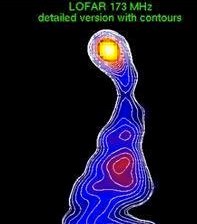
As per Popular Science:
Until recently, radio astronomers have concentrated almost exclusively on the high-energy radiation streaming in towards Earth from exotic stellar bodies like pulsars, quasars, and super-massive black holes. But now, a new European observatory called the Low Frequency Array (LOFAR) has begun releasing data on the low-energy radiation that permeates the Universe.
While seemingly less sexy than high-energy research, low-energy radiation actually allows scientists to look even deeper into the past, to within 500,000 years of the Big Bang, and will provide a much more detailed account of some of the most mysterious periods of the Universe’s earliest days of existence. LOFAR is also going to be used by SETI to search for faint signs of extraterrestrial life.
Heavy, Doc.
[PopSci]
Posted in Aliens, Astronomy, Big Bang | |
Comments (1)
Posted by Justin on April 13th, 2010
As chronicled in yesterday’s New York Times a new wealth of heroes conceived by one of the fathers of modern comics, Jack Kirby, have been unveiled by California animation company whom he worked for later in his career. The firm that owns them, Ruby-Spears Productions, is planning of making them into new comics, cartoons and films.
But which are we most interested in? Golden Shield of course. According to the article:
Among the unrealized projects that Mr. Kirby helped create or contribute to were “Golden Shield,” about an “ancient Mayan hero seeking to save earth in the apocalyptic year 2012.”
Ever the visionary…
Posted in 2012, Apocalypse, Awesome | |
Comments Off on Jack Kirby’s Secret Plan To Stop The 2012 Apocalypse
Posted by Justin on April 13th, 2010

You, me and the rest of the school. Run home, grab any knife you can and meet at the cemetery. We are looking for someone seven feet tall with iron teeth. He already kidnapped and ate two kids, so be careful.
Let’s go kill us a vampire.
Or so was the logic for 400 Scottish kids in late September 1954 when a local constable had to break up the armed youth mob repeatedly after word got out that a massive vampire was picking off students one by one. Of course now it’s just a(n awesome) story that aged schoolmates can tell each other but while it was happening, it caused quite a stir in Glasgow and beyond.
“I think somebody saw someone wandering about and the cry went up: ‘There’s the vampire!’
“That was it – that was the word to get off that wall quick and get away from it.
“I just remember scampering home to my mother: ‘What’s the matter with you?’ ‘I’ve seen a vampire!’ and I got a clout round the ear for my trouble. I didn’t really know what a vampire was.”
There were no records of any missing children in Glasgow at the time, and media reports of the incident began to search for the origins of the urban myth that had gripped the city.
Unfortunately, outside forces seized on the story as a rallying cry to push through legislation regulating comic book content sold to minors. Instead of, I don’t know, lauding and rewarding these brave kids for knowing that brutal mob violence was the safest most efficient way to take down a child-murdering denizen of the undead.
[BBC via Conspiracy Journal]
Posted in Murder, Vampires | |
Comments Off on Why Did 400 Scottish Youths Arm Themselves With Knives To Hunt A Vampire?



